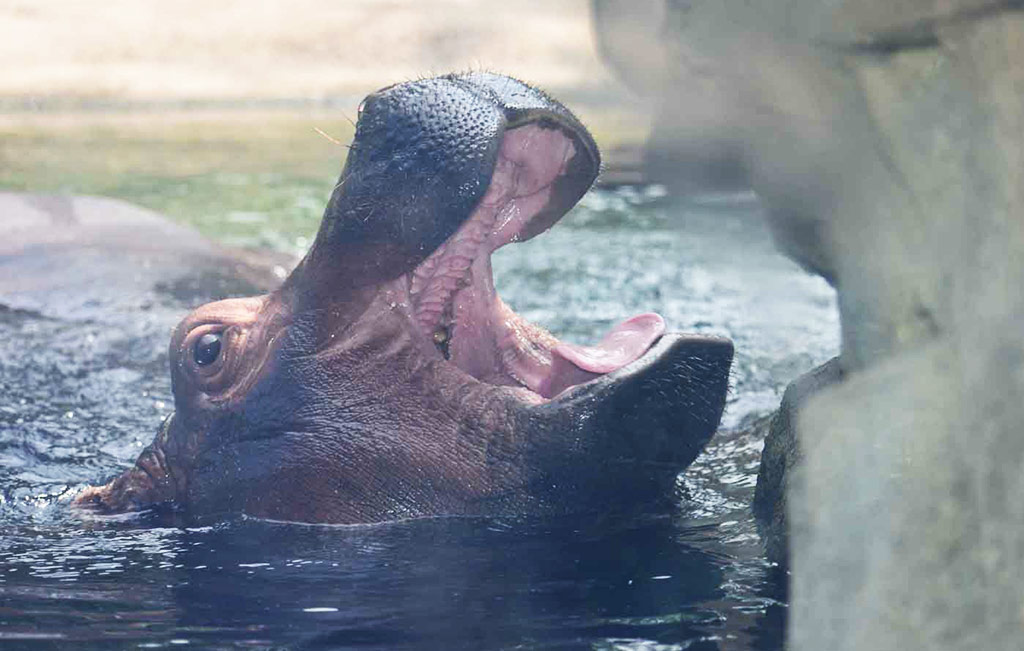
A few years ago, I visited the Cincinnati Zoo and Botanical Garden. In my childhood, I’d spent many days wandering around visiting animals in this same zoo. For 50 years, the Cincinnati Opera performed in a pavilion at the zoo. My parents were opera buffs and attended not only the performances, but also the dress rehearsals. My sisters and I roamed the zoo while they got their opera fix.
Today’s zoo is nothing like the one I grew up with. America’s most sustainable zoo, Cincinnati is a showplace of woodsy winding pathways and ample animal environments. The zoo’s amazing facelift is not why I went to visit, although it certainly piqued my interest. I went to visit Fiona, the famous premature-born baby hippo who weighed a mere 29 pounds at birth. I’d been following her tale of overcoming her rocky beginnings and the heroics of her outstanding care team since three weeks after her birth. Fiona continues to thrive, and now weighs more than 1,600 pounds.
Our zoo day was a typical Midwestern summer day with both temps and humidity in the mid-80s. The morning wasn’t too uncomfortable, but as the day wore on in our five-hour visit, the heat and humidity became oppressive.
The hippos, Fiona and her mother Bibi, were unfazed by the heat. The word “hippopotamus” comes from the Greek word meaning “river horse.” Hippos in the wild spend up to 16 hours a day in the water to escape the heat. We were fortunate to get to watch Fiona and Bibi performing their graceful water ballet for more than an hour.
The other animals, including normally active animals like meerkats, were quite sedate. Most were sprawled out sleeping or awake and unmoving in shady oases. They had the right idea.
Animal Wisdom for Your Summer Yoga Practice
This made me think about how we approach summer yoga practice. In order to accommodate 9-to-5 work schedules, most classes, including several of my own, take place in the hottest part of the day. It’s true that most don’t take place outdoors, and some even take place in air-conditioned spaces.
Still, because of the propensity for popular yoga classes to focus on Vinyasa—fast, flowing movement, often in heated rooms—the trend seems to run counter to the instincts of even the most naturally active of the zoo animals I encountered. The animals knew to slow down and preserve their energies during the hot afternoon. In the heat of summer, non-human animals understand that producing even more heat through excessive activity overheats their bodies and likely saps the energy they may need later on to hunt for food or escape predators.
4 Ways to Cool Down Your Summer Yoga Practice
How can we follow their example? There are several ways, and they don’t all involve giving up your active yoga asana practice. Here are a few of the ways I practice and teach with the intention to minimize the possible heating effects of movement:
- Choose poses that don’t create excessive heat. Emphasize supported poses, including supported backbends; seated or lying-down twists; forward bends; and balancing poses. Avoid emphasizing abdominal strengthening poses, deep backbends and extreme poses that force your body into positions that inhibit your ability to breathe deeply.
- Slow it down. There is such a thing as slow-flow Vinyasa. If you prefer a flowing style of practice, you don’t have to give that up. Just try moving more slowly and mindfully, giving attention not only to the formal poses in your flow, but to the transitions between asanas as well. An added benefit to a slower, more mindful practice is that you are less likely to accidentally push past your healthy range of motion. Continually pushing your range of motion can damage joints over time.
- Avoid heated yoga rooms, at least for the summer. In the heat of summer, our bodies are already chronically overheated. Practicing yoga in a hot room may exacerbate this. It’s true that there are people whose bodies love excess heat. Perhaps practicing in a heated room may be less of an issue for heat-loving individuals. But for the rest of us, excessive heat can sap energy reserves.
Cool Your Intention
Here’s another tip that’s a little more subtle:
Practice with cooling intention. When I was studying in India, Geeta Iyengar spent an entire practice encouraging us to practice with what she called a “cooling intention.” She taught that we could practice normally heating poses such as standing poses without generating excessive heat. When we practice with forcefulness, with an intention to “get somewhere” in an asana, we create tension, and therefore, heat. We can, instead, settle back into our bodies and allow each asana to unfold incrementally without pushing or forcing. When we practice without trying to push to extremes in order to satisfy our concept of what the asana should look like, we create less stress and therefore, less heat. This is subtle, but it does work.
Our bodies, like those of our fellow animals, are designed to move. We don’t have to avoid movement entirely in the sweltering days of summer. But we can learn about smart, energy-saving ways to create a summer yoga practice from our animal friends. Practice in the cool of the day, slow down and move with relaxed, mindful intention.
